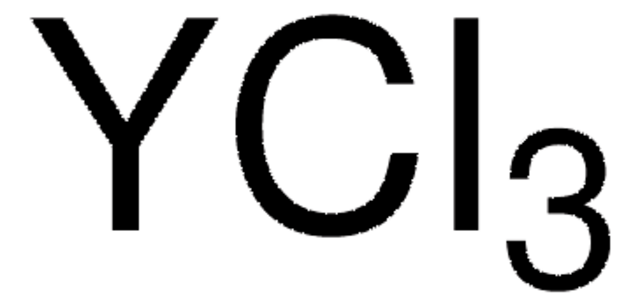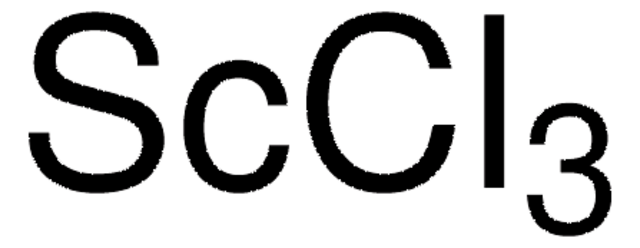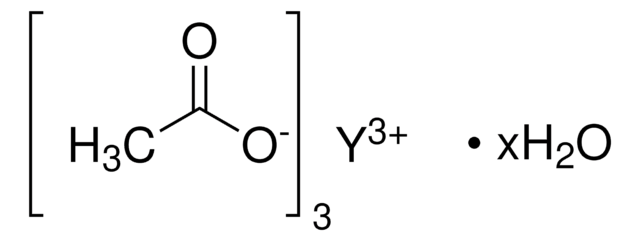464317
Yttrium(III) chloride hexahydrate
99.99% trace metals basis
Sinonimo/i:
Yttrium trichloride hexahydrate
About This Item
Prodotti consigliati
Grado
for analytical purposes
Livello qualitativo
Saggio
99.99% trace metals basis
Stato
powder
Impurezze
≤150.0 ppm Trace Rare Earth Analysis
Punto di fusione
100 °C (dec.) (lit.)
Densità
2.18 g/mL at 25 °C (lit.)
Stringa SMILE
[H]O[H].[H]O[H].[H]O[H].[H]O[H].[H]O[H].[H]O[H].Cl[Y](Cl)Cl
InChI
1S/3ClH.6H2O.Y/h3*1H;6*1H2;/q;;;;;;;;;+3/p-3
IINACGXCEZNYTF-UHFFFAOYSA-K
Cerchi prodotti simili? Visita Guida al confronto tra prodotti
Categorie correlate
Applicazioni
- As a precursor to synthesize Y2O3–MgO nanocomposites via sol-gel processing.
- To prepare finely dispersed yttrium-aluminum garnet (YAG) powder for laser ceramics.
- As an additive to enhance the catalytic performance of activated carbon-supported Au catalyst (Au/AC).
Avvertenze
Danger
Indicazioni di pericolo
Consigli di prudenza
Classi di pericolo
Aquatic Acute 1 - Aquatic Chronic 1 - Eye Dam. 1 - Skin Sens. 1B
Codice della classe di stoccaggio
11 - Combustible Solids
Classe di pericolosità dell'acqua (WGK)
WGK 3
Punto d’infiammabilità (°F)
Not applicable
Punto d’infiammabilità (°C)
Not applicable
Dispositivi di protezione individuale
dust mask type N95 (US), Eyeshields, Gloves
Scegli una delle versioni più recenti:
Possiedi già questo prodotto?
I documenti relativi ai prodotti acquistati recentemente sono disponibili nell’Archivio dei documenti.
I clienti hanno visto anche
Articoli
The rare earth elements impact nearly everyone in the world. All of the people living in advanced technological countries and almost all those living in third world countries utilize the rare earths in their everyday living—the car that one drives (gasoline is refined from oil using rare earth catalysts and catalytic converters reduce the polluting emissions from the automotive exhaust), watching the news on TV (the red and green colors in TV screens), the telephones and computers we use to communicate (the permanent magnets in speakers and disc drives), just to name a few examples.
Il team dei nostri ricercatori vanta grande esperienza in tutte le aree della ricerca quali Life Science, scienza dei materiali, sintesi chimica, cromatografia, discipline analitiche, ecc..
Contatta l'Assistenza Tecnica.












